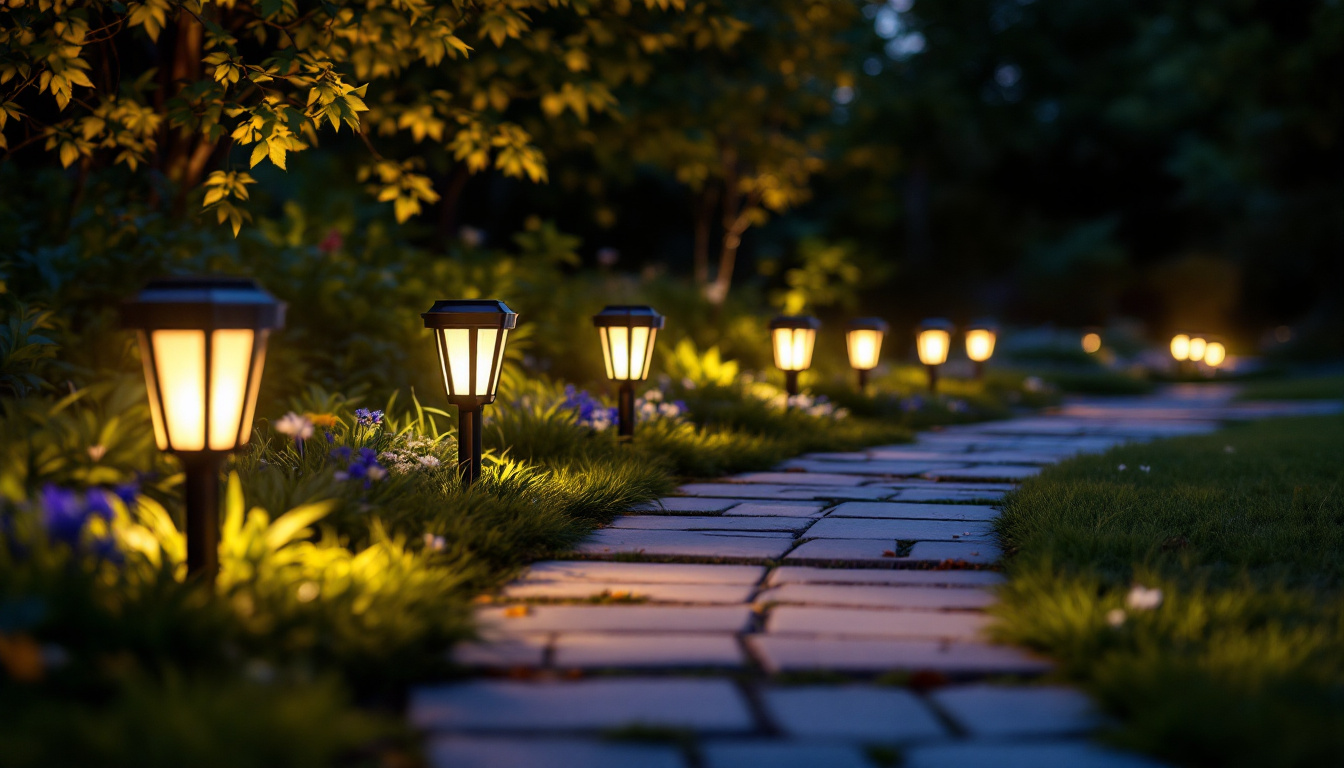
In the realm of outdoor lighting, solar lights have emerged as a popular choice for illuminating walkways. As a lighting contractor, understanding the nuances of solar lighting can significantly enhance your service offerings. This article delves into various hacks and strategies that can elevate your installation projects, ensuring clients enjoy both functionality and aesthetics.
Before diving into the practical hacks, it’s crucial to grasp the fundamentals of solar lighting technology. Solar lights operate by converting sunlight into electricity, which is stored in batteries for use after dark. This self-sustaining feature makes them an eco-friendly option for illuminating pathways. Additionally, advancements in solar technology have led to increased efficiency and longer-lasting performance, making solar lights a viable choice for both residential and commercial applications. With the growing emphasis on sustainability, more people are turning to solar lighting as a way to reduce their carbon footprint while still enjoying the benefits of outdoor illumination.
Solar lights typically consist of several key components: solar panels, batteries, LED bulbs, and sensors. The solar panel collects sunlight during the day, while the battery stores energy for nighttime use. LED bulbs are favored for their energy efficiency and longevity, and sensors help automate the lighting system, turning it on and off based on ambient light levels. Furthermore, some solar lights are equipped with motion sensors, which can enhance security by illuminating areas when movement is detected. This feature not only conserves energy but also provides an added layer of safety for homeowners and businesses alike.
There are several types of solar walkway lights available, each with its unique benefits. Path lights provide illumination along walkways, while spotlights can highlight specific features like trees or garden beds. Solar bollard lights offer a modern aesthetic and are often used in commercial settings. Understanding these options allows contractors to recommend the best solutions for their clients’ needs. Additionally, solar string lights can create a whimsical atmosphere for outdoor gatherings, while solar floodlights are ideal for larger areas that require extensive lighting coverage. Each type serves a specific purpose, enabling users to tailor their outdoor lighting to suit their unique environments and preferences.
Installing solar lights may seem straightforward, but there are several hacks that can optimize performance and enhance the overall aesthetic of the installation. These tips can help contractors ensure that their projects stand out and meet client expectations.
One of the most critical aspects of solar light installation is selecting the right location. Solar panels require direct sunlight to charge effectively, so it’s essential to avoid shaded areas caused by trees, buildings, or other obstructions. Conducting a site assessment before installation can help identify the best spots for optimal sunlight exposure.
Additionally, consider the orientation of the solar panels. Positioning them to face south (in the northern hemisphere) can maximize sun exposure throughout the day. This strategic placement can significantly enhance the efficiency of the solar lights, ensuring they provide adequate illumination during the night. Furthermore, it’s wise to take seasonal changes into account; the angle of the sun shifts throughout the year, so a location that is ideal in summer may not be as effective in winter. Regularly monitoring the performance of the lights can help identify any adjustments needed for different seasons.
Incorporating smart sensors into solar lighting systems can greatly enhance their functionality. Motion sensors can detect movement and activate the lights only when needed, conserving battery life and reducing energy waste. This feature not only extends the lifespan of the lights but also adds an element of security for homeowners.
Moreover, some advanced solar lights come with dusk-to-dawn sensors that automatically turn the lights on at sunset and off at sunrise. This automation simplifies the user experience and ensures that the lights are always operational when needed. Additionally, integrating smart technology allows for remote control and monitoring via smartphone apps, giving users the ability to adjust settings and receive notifications about battery life or performance issues. This level of control can be particularly beneficial for larger installations, where managing multiple lights can become cumbersome without a centralized system.
While functionality is paramount, aesthetics play a vital role in client satisfaction. The design of solar lights can significantly impact the overall look of a walkway. Here are some design considerations to keep in mind during installation.
When selecting solar lights, it’s essential to consider the architectural style of the home and the surrounding landscape. For instance, modern homes may benefit from sleek, minimalist solar fixtures, while traditional homes might look better with classic lantern-style lights. This attention to detail can enhance curb appeal and create a cohesive look.
Additionally, consider the color temperature of the LED bulbs. Warmer tones can create a cozy atmosphere, while cooler tones can provide a more contemporary feel. Offering clients a range of options allows them to choose lights that best fit their vision. Furthermore, the finish of the fixtures—whether matte, glossy, or textured—can also influence the overall aesthetic. A matte black finish can lend a sophisticated touch to a modern setting, while a brushed bronze might complement rustic or vintage designs beautifully.
Layering different types of lighting can create a more dynamic and inviting atmosphere. Combining solar pathway lights with ambient lighting from solar wall sconces or decorative string lights can enhance the overall effect. This layered approach not only improves visibility but also adds depth and interest to the outdoor space.
Moreover, consider the placement of these lights to maximize their impact. For example, strategically positioning solar lights along the edges of a garden path can guide guests while highlighting the beauty of surrounding flora. Incorporating uplighting on trees or architectural features can create dramatic shadows and textures, transforming a simple walkway into a captivating visual experience. By thoughtfully arranging these elements, you can create an enchanting outdoor environment that not only serves a practical purpose but also invites relaxation and enjoyment during evening hours.
To ensure that solar lights continue to perform well over time, proper maintenance is essential. Educating clients on maintenance practices can improve their satisfaction and reduce the likelihood of service calls.
Solar panels need to be kept clean to function effectively. Dust, dirt, and debris can accumulate on the surface, blocking sunlight and reducing charging efficiency. Recommend that clients periodically clean the solar panels with a soft cloth and mild soap to maintain optimal performance.
It’s also important to check the LED bulbs for any signs of wear or damage. Replacing bulbs as needed can prevent dark spots along walkways and ensure consistent illumination. In addition to regular cleaning, clients should be reminded to inspect the surrounding area for overgrown foliage or obstructions that may cast shadows on the solar panels. Trimming back plants or relocating lights can significantly enhance their efficiency and overall brightness.
The lifespan of solar lights largely depends on the quality of the batteries used. Encourage clients to invest in high-quality rechargeable batteries, as they tend to last longer and perform better. Additionally, inform them about the signs of battery degradation, such as dimming lights or shorter illumination periods, so they can replace batteries promptly.
Moreover, clients should be educated on the importance of seasonal battery maintenance. During the winter months, for instance, batteries may be more susceptible to cold temperatures, which can affect their performance. Suggest that clients store their solar lights indoors during extreme weather conditions or use insulation methods to protect the batteries. This proactive approach can help extend the life of the batteries and ensure that the solar lights are ready for use when the warmer months return.
As technology continues to evolve, so do the options available for solar lighting. Embracing smart technology can set contractors apart in a competitive market.
Many modern solar lights can now be integrated with smart home systems. This allows homeowners to control their lighting remotely via smartphone apps or voice commands. By offering these advanced options, contractors can appeal to tech-savvy clients looking for convenience and innovation.
Furthermore, smart solar lights can often be programmed to adjust brightness levels based on the time of night or the presence of movement, providing both energy efficiency and enhanced security.
Utilizing data analytics can help contractors make informed decisions regarding solar light installations. By analyzing factors such as sunlight exposure, client preferences, and environmental conditions, contractors can tailor their recommendations for each project. This data-driven approach can lead to more successful installations and satisfied clients.
Solar lights for walkways offer an eco-friendly and cost-effective solution for outdoor illumination. By understanding the technology, optimizing installations, and incorporating design considerations, lighting contractors can enhance their service offerings and meet the diverse needs of their clients.
Moreover, staying informed about technological advancements and maintenance practices can ensure that installations remain functional and aesthetically pleasing for years to come. By implementing these hacks, contractors can position themselves as experts in solar lighting, ultimately leading to increased client satisfaction and business growth.
In a world increasingly focused on sustainability, the demand for solar lighting solutions will only continue to grow. Embracing these strategies will not only benefit contractors but also contribute to a greener future.
Ready to take your solar walkway lighting projects to the next level? At LumenWholesale, we provide lighting contractors with the highest quality, spec-grade solar lighting products at unbeatable wholesale prices. Say goodbye to local distributor markups and hello to superior lighting solutions that meet the highest industry standards. With our hassle-free bulk buying and free shipping, you can equip your installations with premium lighting while enjoying the best value. Elevate your lighting game and contribute to a sustainable future with LumenWholesale. Discover our extensive selection and experience the perfect blend of quality, affordability, and convenience today by visiting Wholesale Lighting at the Best Value.

Illuminate your projects with confidence using our essential checklist for outdoor solar path lights.

Discover the latest trends in outdoor solar lighting that every contractor should be aware of.

Explore the importance of choosing the right lighting alternatives in installations, uncovering how innovative solutions can enhance ambiance, energy efficiency, and sustainability in modern spaces..

Discover the top benefits of Frame Light LED for lighting contractors, including energy savings, durability, and easy installation—boost your projects today!.